Content from the Brookings Doha Center is now archived. In September 2021, after 14 years of impactful partnership, Brookings and the Brookings Doha Center announced that they were ending their affiliation. The Brookings Doha Center is now the Middle East Council on Global Affairs, a separate public policy institution based in Qatar.
Introduction
Tunisia was one of the first countries in the Middle East and North Africa (MENA) to successfully contain the coronavirus outbreak (see Figure 1). The country recorded zero new cases for five consecutive days starting May 11, completed its deconfinement plan between May 4 and June 14, opened its borders for tourism starting June 27, and resumed normal economic activity.
As of July 17, Tunisia had performed over 81,300 tests. It had recorded 1,327 total contaminations, 1,093 recovered patients, and 50 total deaths. Compared to the rest of the region, Tunisia has good COVID-19 mortality and recovery rates (3.8 percent and 82.4 percent respectively).
Figure 1: Tunisia: Cases and Deaths per Capita Compared to the MENA

 Source: Max Roser, Hannah Ritchie, Esteban Ortiz-Ospina and Joe Hasell (2020) – “Coronavirus Pandemic (COVID-19: Tunisia”. Published online at OurWorldInData.org. Retrieved from: https://ourworldindata.org/coronavirus/country/tunisia?country=~TUN#citatio
Source: Max Roser, Hannah Ritchie, Esteban Ortiz-Ospina and Joe Hasell (2020) – “Coronavirus Pandemic (COVID-19: Tunisia”. Published online at OurWorldInData.org. Retrieved from: https://ourworldindata.org/coronavirus/country/tunisia?country=~TUN#citatio
Tunisia’s success in dealing with the pandemic can be attributed to a combination of factors, including a relatively robust healthcare system, a swift and effective government response, citizen trust in government performance, and public awareness of the dangers of the virus. Yet, despite the government’s effective management of the public health crisis, Tunisia faces significant challenges that may motivate future contestation. Chief among them are deeply rooted economic vulnerabilities that have been exacerbated by the pandemic’s economic impact, along with profound disparities in access to affordable and high-quality healthcare.
Government Responses
Immediately after the first cases were recorded in Tunisia on March 2, the government responded swiftly with a comprehensive set of measures aiming to slow the virus’ progression (see Figure 2). The government suspended all travel, mandated working from home for non-essential workers, closed mosques, imposed mandatory confinement and nightly curfews, shut down schools and businesses, and banned public gatherings. Military and police forces were tasked with ensuring that these instructions were followed.
Figure 2 Timeline of Government Responses to the pandemic

Source: Zouhair ElKadhi, Dalia Elsabbagh, Aymen Frija, Thouraya Lakoud, Manfred Wiebelt, and Clemens Breisinger, “The Impact of COVID-19 on Tunisia’s Economy, Agri-food System, and Households,” International Food Policy Research Institute (IFPRI) Middle East and North Africa, Regional Program Policy Note no. 5, May 2020, 8, http://www.itceq.tn/wp-content/uploads/files/notes2020/COVID19-Tunis.pdf; “al-’istratijiya al-wataniya lilhajar al-sihi al-muwajah [National strategy for targeted containment],” Tunisian Ministry of Local Affairs, accessed May 27, 2020, http://www.collectiviteslocales.gov.tn/02052020/.
The transparency and straightforwardness of decision-making in Tunisia led to a well-organized and effective government response. The major decision-makers during the crisis were President Kais Saied and then Prime Minister Elyes Fakhfakh. The parliament granted the prime minister greater powers to deal with the crisis by activating article 70 of the constitution on April 4. Other major actors driving the effective government response were the minister of public health (Abdellatif Mekki) and the minister of interior (Hichem Mechichi). Decision-makers were supported by senior, medically-trained officials, notably the director General of Military Health (Mustapha Ferjani), the director General of the National Observatory of New and Emerging Diseases (Nissaf Ben Alaya), and the director of the National Center for Transplants (Tahar Gargah).
Moreover, the government’s communication strategy during the crisis- spearheaded by the director of the National Observatory of New and Emerging Diseases- was transparent and extensive. It included daily press conferences that were broadcasted on national and local television and radio stations, a regularly-updated website created by the government, and two Facebook pages dedicated to sharing information about the virus.
Strong Healthcare System
Tunisia has the advantage of possessing one of the most advanced, effective, and better-resourced healthcare systems in the MENA region, with relatively high health expenditure per capita and capacity, strong public health infrastructure, and highly organized pre-existing health structures. Tunisia has spent more in health expenditure than several of its neighbors; the country boasts 2,085 primary care centers and 135 hospitals.
Importantly, it has strong health structures and institutions that were prepared to face the pandemic, which helped the government with both its security and health-related responses to the crisis. They include the National Observatory of New and Emerging Diseases, the Response and Relief Organization, and the Regional National Committee for Disaster Prevention. These institutions were able to collaborate with a newly created authority- the National Coronavirus Response Authority (NCRA)- to centralize responses to the pandemic, follow its epidemiological development, and control its spread. At the local level, municipal councils, aided by civil society organizations and political parties, coordinated with national institutions to implement additional, more targeted measures.
The Role of the Public
Beyond government performance and a relatively strong public health infrastructure, Tunisia also benefited from popular awareness and readiness to follow government instructions during the crisis. In fact, 64.7 percent of those surveyed reported that they fully abided by the restrictions and 99.2 percent reported that they would voluntarily quarantine for 14 days if they suspected infection. Despite dire economic prospects, 42 percent of those surveyed replied they could tolerate a lockdown period longer than one month, and 57 percent advocated for keeping the national lockdown.
Tunisians’ readiness to follow the government’s instructions may be linked to their awareness of the dangers of COVID-19, their trust in the government, and the latter’s extensive communication with the public during the crisis. 81 percent of surveyed Tunisians were aware of the dangers of the virus, and 91.3 percent believed the virus could spread rapidly. Furthermore, the majority of Tunisians trusted their government to control the outbreak (71.2 percent) and to communicate effectively with the public during the crisis (84.5 percent). Increased public trust in government may be linked to the recent change in leadership (prior to which only 20 percent of those surveyed said they trusted the government) and to popular approval of government health response (88 percent) and security measures (82 percent).
Challenges to Come
However, the pandemic has highlighted major flaws within Tunisia’s healthcare system: it is fragile and overburdened in terms of capacity, and it suffers from geographic disparity. There are only around 500 intensive care unit beds across the country (public and private sectors combined), and the public health sector accounts for 87 percent of hospital bed capacity. This means that Tunisia does not have the necessary resources to provide care for a mass influx of patients. Furthermore, not all Tunisians have the same access to health resources. Coastal regions benefit from greater numbers of specialized doctors, ventilators, screening and testing services, intensive care units, and hospital accommodation. This disparity may motivate future contestation, as citizens and opposition actors re-focus on issues relating to healthcare and inequality. To strengthen the public healthcare sector and provide equal access to all regions, the government must increase public health expenditure and must focus on a more equal distribution of health care workers and equipment, especially for the marginalized interior regions.
Tunisia is also facing economic problems. The country was already struggling prior to the outbreak due to deeply rooted structural challenges, including unsustainable levels of public spending (30 percent), high levels of inequality, towering public debt (71.4 percent of GDP), and high youth unemployment. This will be exacerbated by the far-reaching impact of the global pandemic on key sectors and markets. Travel restrictions will harm the tourism sector, which accounted for 14.2 percent of GDP and employed 11 percent of the workforce in 2019. This sector may see a loss of $1.4 billion in revenues and 400,000 in travel-related jobs. Related hotel businesses will also be affected as 60 percent of hotels may end up closing for the summer. Mandatory confinement has deeply hurt the informal sector, which represents between 38 and 53 percent of GDP and employs nearly 60 percent of the workforce. While the government has taken measures to help these workers and other vulnerable citizens (e.g. one-off cash transfers, support packages, and grants) these are not sufficient to alleviate economic hardship.
As a result, Tunisia’s economy may contract by around four percent according to the IMF. The Ministry of Development, Investment, and International Cooperation and the United Nations Development Program (UNDP) estimate that there will be 274,500 job losses and predict that the poverty rate will increase by 4 percentage points. The investment rate is likely to decrease by nearly five percent.
Conclusion
The Tunisian government has successfully contained COVID-19, thanks to a strong institutional response combined with public trust and awareness. However, this fledgling democracy may be threatened by the socioeconomic fallout from the outbreak. The economy is bound to contract as key sectors and trade flows are disrupted and public spending increases. Strained economic conditions may lead to heightened social tension and stronger impetus for socioeconomic reform, driven by an outbreak-inspired focus on social inequality and geographic disparity in the distribution of healthcare resources.
The Brookings Institution is committed to quality, independence, and impact.
We are supported by a diverse array of funders. In line with our values and policies, each Brookings publication represents the sole views of its author(s).
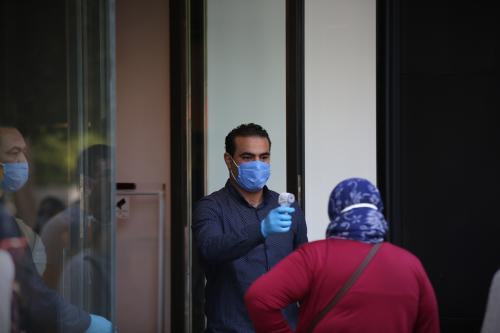
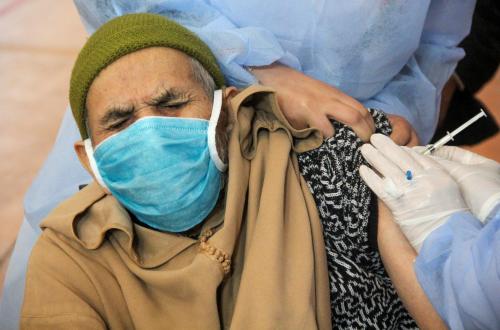
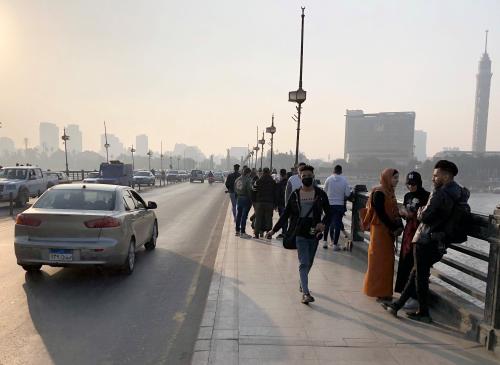

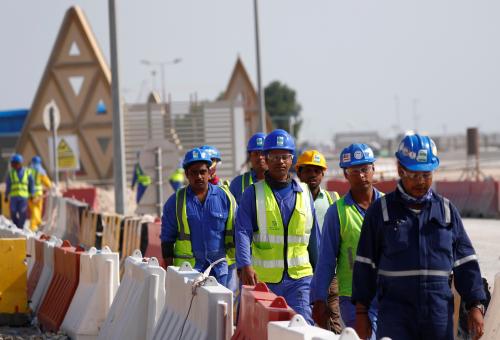
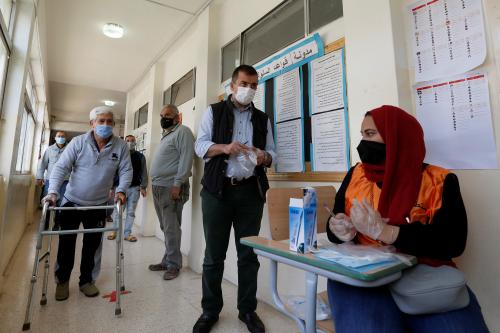

Commentary
Op-edTunisia may have beaten COVID-19, but challenges persist
July 30, 2020